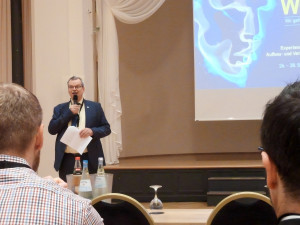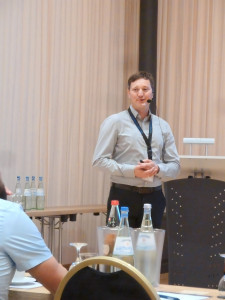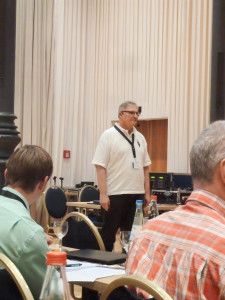Last fall, the expert seminar 'Wir gehen in die Tiefe' (We go deep) on trends in assembly and connection technology attracted a large number of visitors to Dresden.
 The ceremoniator with the bell: WgidT was once again moderated by Prof. Dr.-Ing. Mathias Nowottnick, University of RostockForyears, 'Wir gehen in die Tiefe' (WgidT) has been a fixture for the professional exchange of ideas on the optimization of production processes in electronics manufacturing. In 2023, the event at the 'Mighty Twice' hotel in Dresden was once again a much-anticipated event in the second half of the year. Twelve specialist contracts, spread over two event days at the end of September, awaited the audience - as well as the highly valued exchange of experiences with experts and colleagues. PLUS took part in the first day of the event at the end of September.
The ceremoniator with the bell: WgidT was once again moderated by Prof. Dr.-Ing. Mathias Nowottnick, University of RostockForyears, 'Wir gehen in die Tiefe' (WgidT) has been a fixture for the professional exchange of ideas on the optimization of production processes in electronics manufacturing. In 2023, the event at the 'Mighty Twice' hotel in Dresden was once again a much-anticipated event in the second half of the year. Twelve specialist contracts, spread over two event days at the end of September, awaited the audience - as well as the highly valued exchange of experiences with experts and colleagues. PLUS took part in the first day of the event at the end of September.
'Wir gehen in die Tiefe' enjoys cult status in the industry. Many people did not want to miss out on the specialist presentations and the 'must-see' presentations by the company representatives in attendance. This time, the expert seminar was not organized by Thorsten Schmidthausen (2ndMax), but by the partner companies ASMPT, ASYS Group, Christian Koenen, Rehm Thermal Systems, Vliesstoff Kasper and Stannol, who presented themselves at the accompanying exhibition. In organizational terms, Schmiedhausen's 'big shoes to fill' had to be filled, which was certainly a challenge. Once again, Prof. Dr.-Ing. habil. Mathias Nowottnick, University of Rostock, took over the moderation of WgidT and announced the end of the breaks with a striking bell sound.
Conception of THT production lines
Philipp Fischer, Siemens, kicked things off with a talk about the fully automated THT production line with siplace pick-and-place machines from ASMPT. The line concept created by Siemens is based on the industrial automation systems of the SIMATIC family. Fischer presented the ASMPT line concept as an example. For example, magazine unloaders and transport modules from ASYS, the SIPLACE SX pick-and-place machine from ASMPT and the Selectline selective soldering system from SEHO are integrated, which manage automated loading, placement, soldering, brushing, AOI testing and finally unloading in the line. Fischer picked out specific aspects of the automated THT production line and pointed in particular to the increased variance of components, which also increases the complexity of assembly enormously due to special shapes. According to Fischer, this spurs innovations in line design: improved horizontal and vertical machine communication, full traceability for THT components and the use of AI, for example to reduce AOI 'pseudo errors'. At the end of the presentation, Prof. Nowottnick noted that THT had obviously "not yet been written off".
Sustainable coating
Manuel Schwarzenbolz, Rehm Thermal Systems, spoke on the subject of 'Sustainable coating'. Rehm has long been facing the challenges of becoming more sustainable as an industrial company - if only because the EU's Corporate Sustainability Reporting Directive (CSRD) came into force at the beginning of 2023. On the one hand, this requires a sensible rethink for companies in every industry, but it also leads to absurdities whenCO2 savings are proclaimed as an 'advertising strategy' and 'climate-positive' cat food is advertised on posters. In the case of protective coatings for assemblies (conformal coating), which Rehm applies with the ProtectoXP and ProtectoXC dispensing and coating systems, the question of sustainability arises. The coating itself serves to protect sensitive electronics and thus ensure their longevity - at the same time, acrylic resin coatings containing VOCs are problematic for the environment and health. Water-dilutable coating lacquers are ecologically safer; in the case of bio-based materials, the petroleum content is even completely replaced by renewable raw materials. Car manufacturer BMW is already experimenting with bio-based industrial coatings. However, their use is not yet economically viable. Schwarzenbold also discussed UV-curing protective coatings, which are solvent-free and chemically resistant. However, they also have disadvantages such as greater susceptibility to soiling, higher maintenance requirements and higher material costs. The energy consumption of the mercury vapor lamps required for curing is high - so far, they can only be replaced by LED technology to a limited extent. Schwarzenbold made it clear that there is currently no alternative to mercury vapor lamps in the industrial sector - and so there was a question mark at the end of the presentation: What steps can be taken to actually improve the eco-balance of conformal coating? The approaches are promising, but the industry has not yet reached its goal.
Insight into semiconductor production
 Dr. Florian Schall, Carl Zeiss SMTDr. Florian Schall, Carl Zeiss SMT (Semiconductor ManufacturingTechnology), began his presentation on semiconductor manufacturing almost apologetically - although there is enormous interest in view of the increasing number of semiconductor fabs in Europe. Schall gave an insight into lithography processes in the production of semiconductor chips. Zeiss supplies the optics for its partner ASML, a major Dutch supplier of lithography systems for the semiconductor industry. Schall explained the basics of microchip wafer production, but also mentioned the changes in this technology. Not everyone was aware that mirrors are now used instead of lenses for exposure, as they do not absorb light - nor that these mirrors are becoming ever larger and heavier in order to improve their precision in the picometer range. Schall indicated that the 'magic physical limit' had been reached so often that further improvement seemed unthinkable according to the law. However, Zeiss has always been proven wrong. For example, previous DUV lithography systems used light with a minimum wavelength of 193 nm. In the meantime, extreme ultraviolet light (EUV) has a wavelength of 13.5 nm, which is 15 times shorter and enables chip structures that are 5,000 times thinner than a human hair. The limits of what is possible are therefore being pushed further and further. The Ångström era is dawning in lithography: An Ångström, unit symbol Å - so named after the Swedish physicist and astronomer Anders Jonas Ångström - is a unit of length commonly used in spectroscopy in the order of an atomic diameter. We can only guess how much this microscopization will change semiconductor production - and subsequently PCB production and surface mount technology (SMT).
Dr. Florian Schall, Carl Zeiss SMTDr. Florian Schall, Carl Zeiss SMT (Semiconductor ManufacturingTechnology), began his presentation on semiconductor manufacturing almost apologetically - although there is enormous interest in view of the increasing number of semiconductor fabs in Europe. Schall gave an insight into lithography processes in the production of semiconductor chips. Zeiss supplies the optics for its partner ASML, a major Dutch supplier of lithography systems for the semiconductor industry. Schall explained the basics of microchip wafer production, but also mentioned the changes in this technology. Not everyone was aware that mirrors are now used instead of lenses for exposure, as they do not absorb light - nor that these mirrors are becoming ever larger and heavier in order to improve their precision in the picometer range. Schall indicated that the 'magic physical limit' had been reached so often that further improvement seemed unthinkable according to the law. However, Zeiss has always been proven wrong. For example, previous DUV lithography systems used light with a minimum wavelength of 193 nm. In the meantime, extreme ultraviolet light (EUV) has a wavelength of 13.5 nm, which is 15 times shorter and enables chip structures that are 5,000 times thinner than a human hair. The limits of what is possible are therefore being pushed further and further. The Ångström era is dawning in lithography: An Ångström, unit symbol Å - so named after the Swedish physicist and astronomer Anders Jonas Ångström - is a unit of length commonly used in spectroscopy in the order of an atomic diameter. We can only guess how much this microscopization will change semiconductor production - and subsequently PCB production and surface mount technology (SMT).
Precise heating and low-temperature soldering
Ronald Klaus von Nordheim, Wattron, dealt with digital heating in his presentation. Matrix heating systems, in which many small, individual heating elements enable precise heating to different temperatures, are mainly used in food technology. As von Nordheim jokingly remarked, it comes from an area of packaging that differs fundamentally from that of electronics production. However, digital heating systems from food technology also open up new possibilities for thermosensitive components, for example in the field of 3D electronics. The 'Origami' project should be mentioned here - it was presented in detail in PLUS issue 3/2023.
Markus Braun, Trainalytics, spoke in his compact presentation about low-temperature soldering - a perennial topic at WgidT. As a provider of training courses and training programs for electronics production, Trainalytics offers corresponding expert knowledge in the fields of materials science, materials mechanics, electrical engineering, process and testing technology. Lead-free solder alloys based on tin and bismuth are used in the assembly of highly temperature-sensitive components. How low-temperature soldering affects the reliability of soldered joints is a much-discussed topic that Braun was only able to touch on.
Unfortunate components
 Outdid himself this year: Helge Schimanski, Fraunhofer Institute ISITThehighlightof WgidT on this day was the presentation by Dipl.-Ing. Helge Schimanski, Fraunhofer Institute for Silicon Technology ISIT. Schimanski, who can be described as a permanent fixture at the expert seminar, provided an insight into error analysis as the basis for reliable electronics - in times of component shortages and the increasing number of fake components or re-declared inferior goods whose appearance, packaging and accompanying documents simulate an original origin - until performance and processing expose them. Sifting them out requires increased vigilance. Schimanski presented talking pictures and joked about "missing legs" or broken connections that made a sensor look like Pacman with the corners of his mouth pulled down (Schimanski: "This component doesn't look happy."). He praised failure analysis as the basis for quality, reliability and guaranteed functionality of electronic products in the product life cycle. X-ray analysis, metallography, CT, surface microsection and cross-sectional microsection analysis are at the beginning of root cause analysis. Whether discovered faults can be prevented, avoided or rectified by rework is another matter. Conclusion: Comprehensive presentation of a persistently important topic in component manufacturing - presented by a particularly good-humored Helge Schimanski, who was in full bloom as a speaker.
Outdid himself this year: Helge Schimanski, Fraunhofer Institute ISITThehighlightof WgidT on this day was the presentation by Dipl.-Ing. Helge Schimanski, Fraunhofer Institute for Silicon Technology ISIT. Schimanski, who can be described as a permanent fixture at the expert seminar, provided an insight into error analysis as the basis for reliable electronics - in times of component shortages and the increasing number of fake components or re-declared inferior goods whose appearance, packaging and accompanying documents simulate an original origin - until performance and processing expose them. Sifting them out requires increased vigilance. Schimanski presented talking pictures and joked about "missing legs" or broken connections that made a sensor look like Pacman with the corners of his mouth pulled down (Schimanski: "This component doesn't look happy."). He praised failure analysis as the basis for quality, reliability and guaranteed functionality of electronic products in the product life cycle. X-ray analysis, metallography, CT, surface microsection and cross-sectional microsection analysis are at the beginning of root cause analysis. Whether discovered faults can be prevented, avoided or rectified by rework is another matter. Conclusion: Comprehensive presentation of a persistently important topic in component manufacturing - presented by a particularly good-humored Helge Schimanski, who was in full bloom as a speaker.
The day ended with a buffet in the beer garden of the 'Mighty Twice' and a special evening special: in small groups, the participants tried to escape selected hotel rooms through detective deduction - a kind of 'escape room' light and an original change from the usual standards of such evening events.
We had to skip the second WgidT day due to time constraints - but even if there was still some organizational confusion, most visitors were positive when asked.
"This component doesn't look happy."
Dipl.-Ing. Helge Schimanski
'Wir gehen in die Tiefe' will remain a resounding name as an expert seminar (if only because of Prof. Nowottnick's iconic bell), and the PLUS will follow with interest how the event develops.


